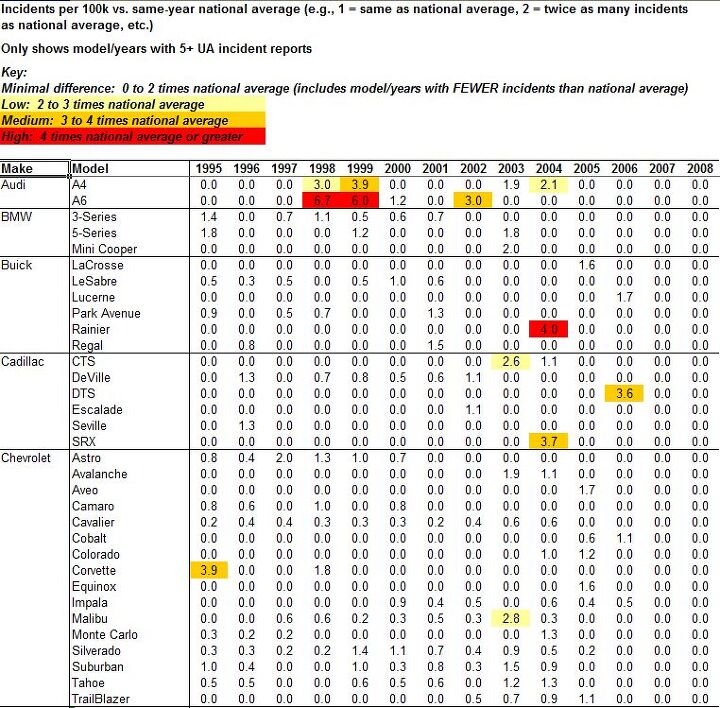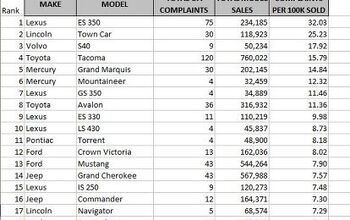NHTSA Data Dive #5: UA Incident Rate By Models 1995-2008
Here’s (perhaps) the finale of David’s remarkable data diving: a full chart showing all makes and models sold from 1995 through 2008, with their rates of reported UA incidents to the NHTSA. To make the findings easier to interpret, David has adjusted all the results as a relationship to the same year average, rather than just the raw results. This really highlights those vehicles with higher than average rates of reported UA.
The table has been inserted full after the jump, as well as our commentary, but if you want to access the excel file in its entirety, it’s here.
David:
This chart lets us directly compare any model/year, because it controls for the number of each model/year vehicle sold, and the number of years it has been on the road. (We want to control for the number of years on the road, because older cars would generate more complaints simply because they’ve been around longer, not necessarily because they’re more prone to UA.)
Here’s an example of how to read the chart, comparing the 1998 Audi A4 with the 1999 Audi A6.
- The 1998 A4 had 3 times as many UA incidents as the average 1998 vehicle.
- The 1999 A6 had 6 times as many UA incidents as the average 1999 vehicle.
- Therefore, we can say that the 1999 A6 is more than twice as likely to have a UA incident as a 1998 A4 (6x is twice as big as 3x).
- This comparison is valid, even though there were more A4s sold than A6s, and even though the A4s have been around for an extra year. These factors are controlled when calculating the numbers shown in the chart.
Some observations about Toyotas and other vehicles:
- Camrys are consistently worse than average for 2002-2005 model years. And the 2007 model has among the worst values for popular vehicles. But 2006 and 2008 Camrys are almost incident-free. The Lexus ES has the exact same pattern. So it appears that the recall (which covers 2007-2010 Camrys) does not target some of the most affected cars (2002-2005). Many of the cars which ARE recalled don’t have a significant UA problem (2008 and 2009–and 2009 has so few problems that it doesn’t even show up on the chart!).
- Toyota has a problem across many of its vehicles, not just Camrys. It’s the only manufacturer where so many model lines have problems after 2002.
- General Motors and Honda are nearly immune to UA issues. GM’s success in preventing UA is surely meaningful, given that it’s a full-line manufacturer with models known to be preferred by older drivers.
- Fords were quite problematic until 2002. Cars from the 2003 or later model years are much less problematic.
- There are many other model/years with incident spikes (e.g,. Volvos and Jaguars), but these are generally much lower-volume vehicles. Since we don’t have much context about their UA history, it’s hard to say if the spikes are meaningful.
Paul:
What seems to stand out is numerous incidents of higher than average UA rates for vehicles just after a new generation is introduced, or the opposite: a dramatic reduction of a high UA car after it is replaced. Some examples of that are:
Ford Expedition: drops off after new ’03 model. Chrysler minivans: spike in UA after new ’96 model introduced. Ford Focus: spike after new model introduced in 2000. Suzuki Grand Vitara/Verona high UA rates drop after new model introduced in ’06.
What is clear to both of us is that issues with pedal location, size and relationship to their surroundings may be a key factor in these changes. This warrants further inquiry.
Latest Car Reviews
Read moreLatest Product Reviews
Read moreRecent Comments
- ToolGuy From the relevant Haynes Repair Manual:"Caution: The 4.6L models require a special tool to extract the water pump from the coolant crossover housing. This special tool is expensive and the removal procedure is difficult. Have the water pump replaced by a dealer service department or other qualified automotive repair facility if the tool is not available."One version of the tool is Lisle 14440; I paid $10.82 (less 5% discount, plus shipping).You can see why I never attempt my own maintenance or repairs. 😉
- Dave M. IMO this was the last of the solidly built MBs. Yes, they had the environmentally friendly disintegrating wiring harness, but besides that the mechanicals are pretty solid. I just bought my "forever" car (last new daily driver that'll ease me into retirement), but a 2015-16 E Class sedan is on my bucket list for future purchase. Beautiful design....
- Rochester After years of self-driving being in the news, I still don't understand the psychology behind it. Not only don't I want this, but I find the idea absurd.
- Douglas This timeframe of Mercedes has the self-disintegrating engine wiring harness. Not just the W124, but all of them from the early 90's. Only way to properly fix it is to replace it, which I understand to be difficult to find a new one/do it/pay for. Maybe others have actual experience with doing so and can give better hope. On top of that, it's a NH car with "a little bit of rust", which means to about anyone else in the USA it is probably the rustiest W124 they have ever seen. This is probably a $3000 car on a good day.
- Formula m How many Hyundai and Kia’s do not have the original engine block it left the factory with 10yrs prior?








































Comments
Join the conversation
I wear 13 2E shoes. I have noticed that I have a lot more problems with pedal placement -- usually hitting both at once -- on my wife's Toyota, than on my Accord. I have often wondered why movable pedals have not been more popular.
Probably 99% of SUA complaints are driver error. Today NHTSA said NY Prius was driver error. California Prius was proven to be a hoax earlier this week. Toyota sales up 40-50% this month. Oh what a feeling !